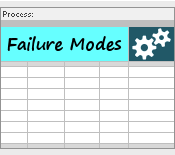
Also Known as Failure Analysis.
Related topics include Risk Analysis, Failure Tree Analysis, Fault Tree Analysis, and reliability Analysis.
FMEA, which stands for Failure Mode and Effects Analysis, is a team-based method used to spot and prevent problems before they happen. It is a risk analysis tool and a structured way to look at a product or process, find possible ways it might fail, understand what could go wrong, and take steps to prevent such failures. Instead of waiting for problems to happen, FMEA helps teams think ahead and protect businesses and customers by improving quality, safety and reliability.
Imagine you’re building a treehouse. Before you start, you list all the things that could go wrong (the wood might be weak, the ladder could break, or someone might fall). You then plan how to prevent potential problems, like choosing stronger wood and adding safety rails. That’s how FMEA works. It helps you think through all possible failures before they occur, making your process safer and more reliable.

Traditional problem-solving is reactive, addressing failures once they arise, whereas FMEA is proactive, preventing failures in advance.
Failure Modes and Effects
So, what is a failure mode in practical terms? A failure mode is the specific way something can go wrong. For example, if a car engine doesn’t start, the failure mode might be a dead battery or fuel not reaching the engine. If a torch doesn’t work properly, the failure mode might be that the light flickers, the torch doesn’t turn on, or the light is too dim. FMEA is about getting an answer to this simple question: what could go wrong?

In FMEA, teams should list all possible failure modes in each process step and analyze their effects and causes. The goal is to identify every realistic way a process can fail and understand how serious each effect could be. The further a failure goes without being fixed, the more damage or cost it may cause. That’s why identifying failure modes early is so important.

Failure modes can be identified by reviewing past experiences and historical data, studying similar products or services and their lessons learned, and examining customer complaints, warranty claims, and returns. Additional insight comes from consulting suppliers, field service teams, and maintenance reports, as well as reviewing regulatory, safety, or quality incidents. Brainstorming sessions also play a key role in uncovering potential ways a process, product, or service could fail.
The effect of a failure, on the other hand, is what happens if something actually goes wrong. These effects can impact customers, safety, or the business itself. When evaluating effects, teams should consider all types of customers, including the next user, downstream users, the ultimate customer, and even government regulators.

In improvement projects such as Lean or Six Sigma, FMEA plays a major role in managing risks. It is used before a project starts to understand project risks, during the project to identify and prevent future failures, and after the project to develop control plans and monitoring systems.
FMEA Types
There are several types of FMEA, depending on the purpose of the analysis. Product FMEA looks at how a product’s components or features might fail, while Process FMEA studies each step in a process to find where problems could happen. Design FMEA focuses on preventing design flaws before production begins, and System FMEA examines larger systems early to ensure they function as intended. Each type helps teams find risks at different stages so that failures are prevented before reaching the customer. For this article, the focus will be on Process FMEA.
Process FMEA examines each step of a process and asks, “How could this step fail?” and “What would happen if it did?” This requires a clear understanding of the process, brainstorming possible failure modes, and analyzing their causes. Here’s a simple example showing one failure mode for each step in the process of making a cup of tea:

Process FMEA also examines several attributes for each failure mode, including the potential effect of the failure if it occurs, the severity of that effect, the potential causes that could trigger the failure, and how often a cause of a failure mode is likely to happen (occurrence). It also considers existing controls designed to prevent or detect failures early, and evaluates the likelihood that these controls will detect the cause before it leads to the failure mode (detection).
The following outlines the process of making a cup of tea, along with its associated key FMEA attributes.

FMEA Chart
The FMEA chart is a structured table where teams record all possible failure modes, their causes, effects, and the actions needed to minimize or prevent potential failures. It helps prioritize risks by assigning a Risk Priority Number (RPN) to each failure mode, which is the primary outcome of the FMEA exercise.
RPN values are calculated by multiplying the severity, occurrence, and detection ratings for each failure mode. The higher the RPN, the greater the risk, and the more urgent it is to take preventive actions to avoid failure. If a failure mode has a low RPN, no action may be needed.
Consequently, it is important that teams, after calculating RPNs, take the necessary preventive actions to prevent or minimize potential failures before they occur and minimize the impact on the process, product, or customer. Clear responsibilities and deadlines should be assigned for each preventive actions to ensure accountability and timely implementation. RPNs can then be recalculated to reflect the effect of the implemented preventive measures.

Click to enlarge image
In FMEA, rating tables are used to assign numerical scores to the severity, occurrence, and detection attributes to ensure a consistent and objective assessment of failure modes. These numerical scores are used to calculate the RPN values, which help identify and prioritize the most critical risks. The team should agree on the rating scale to be applied to the rating tables. Typically, three main rating tables are used, as follows:

Click to enlarge image
Example
Here is the same making a cup of tea process example previously discussed, presented within the FMEA chart.

This example represents the simplest form of an FMEA. However, the chart can grow quickly because each process step may have many potential failure modes and effects, and each failure mode may have many potential causes and many controls to consider. Several sessions may be needed to complete the FMEA exercise thoroughly and accurately.
Conducting an FMEA Exercise
The following points outline the main steps involved in conducting an FMEA:
- Select the process and form the FMEA team.
- Identify the process steps including all inputs and outputs.
- Brainstorm and list possible failure modes.
- Identify the effects and rate their severity (SEV).
- Identify the causes and rate their occurrence (OCC).
- Identify current controls and rate their detection (DET).
- Calculate the risk priority numbers for all failure modes.
- Act on the results by planning and implementing preventive actions.
- Update the FMEA regularly.


There are many tools available to support conducting an FMEA. One of the simplest tools involves using this FMEA chart template.
Wrapping Up
FMEA is all about prevention and stopping problems before they reach customers. Preventing problems is much cheaper than fixing them after they occur. FMEA also teaches teams to be systematic and thorough in thinking about risks, not just reacting after something fails.
By using FMEA, companies save time, money, and reputation, while keeping customers safe and happy. It’s an investment that pays off many times over. In short: FMEA helps you do it right the first time.
References
Kubiak, T. M. The Certified Six Sigma Master Black Belt. Infotech.
Rob, M. Crown Holdings. Process Improvement Program.
Brook, Q. Lean Six Sigma and Minitab: The Complete Toolbox Guide for Business Improvement.
Other Formats


Related Articles
Related Templates








